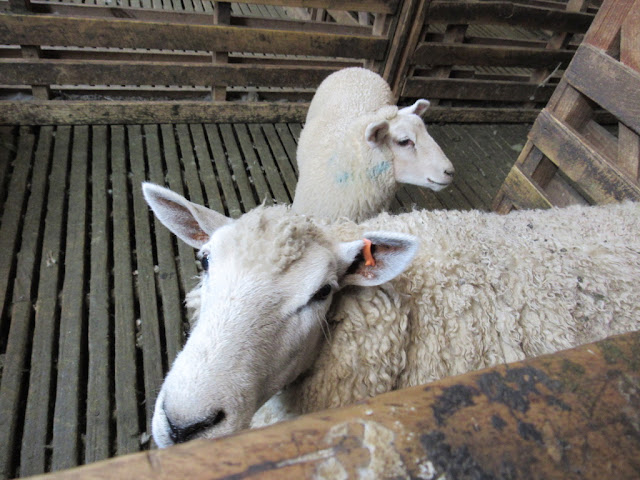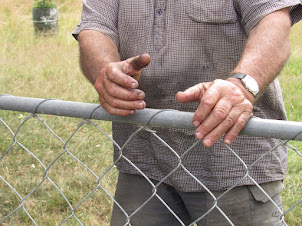Sheep are a major export product in New Zealand. Farmers raise merino wool, which is a very high quality wool. Merino sheep originated in Spain and were brought to New Zealand where they took very well to the climate. Sheep produce wool for about seven years until they can no longer eat the grass.
The sheep station we visited near Fairlie, has 4,000 sheep on 500 hectares (one field is 200 hectares and the other is 300 hectares). The farm was formerly owned by Tom, who still works the farm and is shown below shearing the sheep. He sold it to Mitch and Charlotte, a young couple with three kids, who he helped financially by supplying them with loans. He assists them as much as he can and seems glad that Mitch and Charlotte took over the farm--and that their three sons are in line to take it over from them. It's his legacy.
The process of sheep shearing is letting the sheep know who is the boss. And the sheep learn that it is less a struggle if they cooperate. This mother is showing her newborn how it is done. Tom took less than 5 minutes to shear her. Sheep shearers are paid by the number of sheep they shear, so they learn how to work quickly.



The big, beefy hands of a sheep shearer after years of work with the sheep.
 Jackaroo in training. A
jackaroo is a young man working on a
sheep or cattle station, who gains practical experience in the skills
needed to become an owner, overseer, manager, etc. The oldest son on the
station is starting out his career by learning how to drive the
equipment.
Jackaroo in training. A
jackaroo is a young man working on a
sheep or cattle station, who gains practical experience in the skills
needed to become an owner, overseer, manager, etc. The oldest son on the
station is starting out his career by learning how to drive the
equipment.
The word, jackaroo, originated in Queensland, Australia in the 19th century and is still in use in Australia and New Zealand today. Its origins are unclear, although it is firmly rooted in Australian English, Australian culture , and in the traditions of the Australian stockmen. A jillaroo is a woman. Ringers are cowboys.
As Charlotte said, the family works the farm 24/7/365, but they like the life they live in the place where they live it. It takes place outdoors and ownership allows them to be their own boss. School is five minutes away, and Mitch and Charlotte are satisfied with it for their kids. The kids can play outdoors--and they learn to do the work.
Farming is hard work economically and physically and farmers really struggle to make a living. You can never depend on a stable price: markets shift and situations change. For example, Covid affected the farm in that the workers had to stay clear of it. But the sheep needed tending despite the fact that there were lock-downs and work stoppages. Sheep can get Covid, but apparently they didn't.
On this sheep station, Charlotte and Mitch also raise lamb and mouton, which is less valuable than wool but another way to make money. The difference in the meat is defined by the sheep's teeth. When the lambs get their adult teeth, they become mouton. Farmers in Fairlie are now looking into producing sheep cheese.
In January 2019, there were 27.4 million sheep living in New Zealand. The sheep to person ratio in New Zealand was 5.6 to 1. At one time, the sheep to person ratio in was as high as 22 to 1. As of June 2022, there were approximately 25.14 million sheep in New Zealand, a decrease from the previous year when there were around 25.73 million sheep in the country.
The British brought agriculture to New Zealand and Australia beginning in 1788. They also brought cattle at a time when England was in recession. This included dairy cattle. Agriculture was slower to develop in Australia because of its soils while agriculture in New Zealand took off rather well. (The British also brought deer with them so that they could hunt.) Southland dairy cattle increased sixteen-fold (1,584 percent) from 38,000 to 636,000 while beef cattle decreased by 15.3 percent nationally from 4.6 million to 3.9 million.









No comments:
Post a Comment